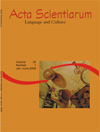<strong>Four nuclei/axes of meaning production in Caio Fernando Abreu’s literary work</strong> - DOI: 10.4025/actascilangcult.v30i1.4048
Abstract
This article presents a short study about the literary work of Brazilian writer Caio Fernando Abreu (1946-1996). In order to study his formal and thematic choices, we established criteria based on concepts like motif and plot (dramatic situation), as developed by Tomachevski (1976). A specific articulation between motives and dramatic situations establishes four nuclei of Abreu’s literary production, which is characterized by a literary experimentation with these elements and it constructs an organic work that makes itself and/or is made in a dialogic way (Bakhtin, 1981). Firstly, the main characteristics of the four nuclei and the books that embody them will be presented. Then, we will describe how the motives and dramatic situations are re-elaborated from one nucleus to another. Not only does each nucleus features some new elements, but also contains remainders of previous ones. As such, each of Abreu’s works can be considered as both the same and unique.Downloads
DECLARATION OF ORIGINALITY AND COPYRIGHTS
I Declare that current article is original and has not been submitted for publication, in part or in whole, to any other national or international journal.
The copyrights belong exclusively to the authors. Published content is licensed under Creative Commons Attribution 4.0 (CC BY 4.0) guidelines, which allows sharing (copy and distribution of the material in any medium or format) and adaptation (remix, transform, and build upon the material) for any purpose, even commercially, under the terms of attribution.
Read this link for further information on how to use CC BY 4.0 properly.




















6.png)









